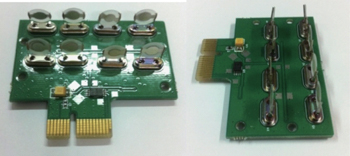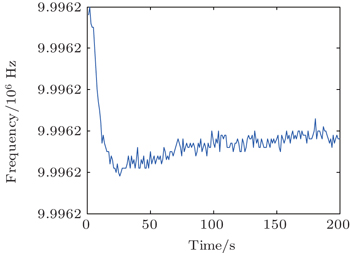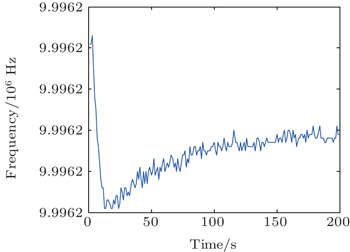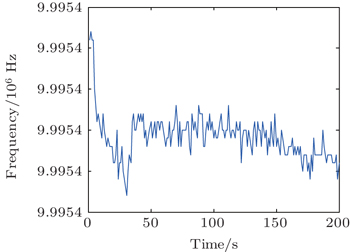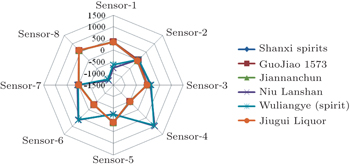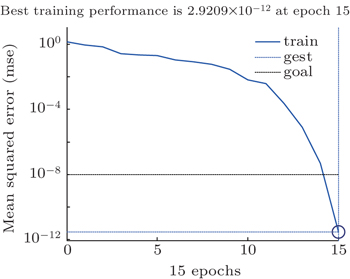† Corresponding author. E-mail:
Project supported by the National High Technology Research and Development Program of China (Grant No. 2013AA030901) and the Fundamental Research Funds for the Central Universities, China (Grant No. FRF-TP-14-120A2).
This paper presents a new pattern recognition system for Chinese spirit identification by using the polymer quartz piezoelectric crystal sensor based e-nose. The sensors are designed based on quartz crystal microbalance (QCM) principle, and they could capture different vibration frequency signal values for Chinese spirit identification. For each sensor in an 8-channel sensor array, seven characteristic values of the original vibration frequency signal values, i.e., average value (A), root-mean-square value (RMS), shape factor value (Sf), crest factor value (Cf), impulse factor value (If), clearance factor value (CLf), kurtosis factor value (Kv) are first extracted. Then the dimension of the characteristic values is reduced by the principle components analysis (PCA) method. Finally the back propagation (BP) neutral network algorithm is used to recognize Chinese spirits. The experimental results show that the recognition rate of six kinds of Chinese spirits is 93.33% and our proposed new pattern recognition system can identify Chinese spirits effectively.
The polymer quartz piezoelectric crystal sensor based e-nose[1] is a machine olfaction device to identify and monitor a variety of chemical gases of interest. It can imitate human senses by using polymer quartz piezoelectric crystal sensor arrays and pattern recognition system. Recently the developments of the polymer quartz piezoelectric crystal sensor, a quality sensitivity sensor outputting vibration frequency signal values, significantly promoted the improvement of the e-nose technology.[2–4] However, the e-nose is still in the early stages of application.
An effective pattern recognition system in the e-nose is needed to distinguish among different kinds of frequency signal values of testing materials. In fact, researchers have proposed many pattern recognition systems to improve the identification performance of the e-nose in market. For example, Chang and Freeman,[5] and Chang et al.[6] modeled a mammalian neural olfactory system that was characterized anatomically by modifiable synaptic connections, and physiologically by the spatiotemporal interactions among neural ensembles under external inputs. Ekachai and Nagle[7] dealt with selecting sensors for e-noses to make a portable device with fast response time, small size and reduced cost. Zhang et al.[8] presented an on-line counteraction of unwanted odor interference based on pattern recognition for the first time. Zhang et al.[9] studied the concentration estimations of indoor contaminants for air quality monitoring in dwellings by using chaos based on an optimal artificial neural network integrated into their self-designed portable e-nose instrument. Pawel and Wojciech[10] presented two innovative systems based on the feed-forward and recurrent neural network used for qualitatively analyzing the specimens of different fruit teas. Kizil et al.[11] developed an artificial neural network (ANN) model to identify the Salmonella enterica in poultry manure, and the accuracy is 94%. Although many successful pattern recognition systems have been designed for the e-nose, they cannot be used for the polymer quartz piezoelectric crystal sensor based e-nose directly. This is mainly because the signals, captured by the polymer quartz piezoelectric crystal sensor array, are nonlinear, and the sensors have cross sensitivity to the testing materials. The existing pattern recognition systems designed for the e-nose cannot extract the characteristic information about the polymer quartz piezoelectric crystal sensor effectively, and they must be updated and improved.
In our previous work, Gu and Li[12] presented a new pattern recognition system based on moving average and linear discriminant analysis (LDA), which could be used to process the original signal values of the new polymer quartz piezoelectric crystal air-sensitive sensor system. But only three kinds of Chinese spirits could be effectively identified and the adaptability of the pattern recognition system needs to be improved. In this paper, we propose another pattern recognition system for the polymer quartz piezoelectric crystal sensor based e-nose. For the vibration frequency signal values of six kinds of Chinese spirits captured by the e-nose, the proposed new pattern recognition system could distinguish from them effectively. The new polymer quartz piezoelectric crystal sensor based e-nose, assembled with the new pattern recognition system, provides us with a new method to distinguish among Chinese spirits.
To identify different kinds of Chinese spirits, a new pattern recognition system for the polymer quartz piezoelectric crystal sensor based e-nose is presented. First, the vibration frequency signal values are obtained by the polymer quartz piezoelectric crystal sensor array. Then for each set of vibration frequency signal values, seven characteristic values are extracted and the principal components analysis (PCA) method is used to reduce the dimension of the characteristic values. Finally the back propagation (BP) artificial neural network method is used to identify different kinds of Chinese spirits.
In this paper, we use the novel polymer quartz piezoelectric crystal sensor array to obtain the signal data of Chinese spirits, which is composed of different kinds of affinity-type polymer quartz piezoelectric sensors and very sensitive to the liquor product material. As shown in Fig.
After studying the components of six kinds of Chinese spirits which are shown in Table
| Table 1. Six kinds of Chinese spirits. . |
| Table 2. Selected polymers for constructing quartz piezoelectric crystal sensors. . |
As the changing trends of different kinds of vibration frequency signal values of Chinese spirits are similar, we extract seven characteristic values from the vibration frequency signal values to improve the accuracy of recognition. The seven characteristic values are average value (A), root-mean-square value(RMS), shape factor value (Sf), crest factor value (Cf), impulse factor value (If), clearance factor value (CLf), and kurtosis factor value (Kv). Our experimental results show that these characteristic values have rich distinctive information. The above characteristic values can be computed from the following equations: for A,







In order to reduce the computational complexity and improve the identification efficiency of the pattern recognition system, the PCA method is used to reduce the dimension of characteristic values. The PCA is a linear feature extraction technology based on data dimension reduction. It uses an orthogonal transformation matrix to project characteristic values from high-dimensional data space to low-dimensional data space, and it can convert characteristic values into a set of linearly uncorrelated values called principal components. Using PCA method, the raw signal values can be represented as a series of principal components. Let X1 X2 … Xn be the raw data, then the k-th principal component PCk will be expressed as follows:

In this paper, the BP neutral network algorithm is used to recognize six kinds of Chinese spirits in the new pattern recognition system. The BP neutral network is a multilayer feedforward network which can be trained by using error back propagation algorithm, and it is an effective method for classification. It can learn and store many input–output model mapping relations without using the descriptive equations of these relationships, and it can minimize the error sum of squares of the network by adjusting the network weights and thresholds.
In the BP neutral network, the number of the hidden layer nodes can be determined by the following equation:

In this paper, six kinds of Chinese spirits are used to testify the performance of the designed new pattern recognition system in the e-nose. First, the 8-channel polymer quartz piezoelectric crystal sensor array is used for signal acquisition. For each kind of Chinese spirit, we capture vibration frequency signals for 2 min at room temperature in a clean room and 200 vibration frequency signal values are acquired. Such a manipulation is repeated 10 times. The signal values from 1st to 5th manipulation are used for training and the signal values from 6th to 10th manipulation are used for testing. Then six kinds of vibration frequency signal values of Chinese spirits can be acquired using the above method. Because of the limitation of length, a set of vibration frequency signal values of six selected kinds of Chinese spirits by sensor-1 are listed in Table
| Table 3. Frequency values of six selected kinds of Chinese spirits, detected by sensor-1. . |
For each set of vibration frequency signal values, seven characteristic values of six kinds of Chinese spirits are computed by using the signal values from 1st to 5th manipulation. Averaging each kind of characteristic value, we could obtain the characteristic values of six kinds of Chinese spirits. Taking the sensor-1 for example, the average characteristic values are shown in Table
| Table 4. Average characteristic values of six kinds of Chinese spirits (sensor-1). . |
As shown in Table
| Table 5. Principal components of seven characteristic values. . |
As shown in Fig.
Finally, the BP neutral network is trained in the Matlab software. The number of hidden layer nodes is set to be 6, the maximum training time is set to be 1000, the minimum mean square error is set to be 1 × 10−8, and the training goal is set to a 6×6 unit matrix. The training performance of the BP neutral network is shown in Fig.
| Table 6. Recognition results. . |
This paper presents a new pattern recognition system to distinguish among six kinds of Chinese spirits by using a polymer quartz piezoelectric crystal sensor e-nose. First, seven characteristic values of six kinds of vibration frequency signal values of Chinese spirits, i.e., A, RMS, Sf, Cf, If, CLf, and Kv are extracted. Then the PCA method is used to reduce the dimension of the characteristic values. Finally, the first principal components are used to train the BP neutral network and the trained BP neutral network is used to recognize Chinese spirits. The recognition results show that the recognition rates of six kinds of Chinese spirits are 93.33%. Our proposed new pattern recognition system provides us with a highly innovative method to recognize Chinese spirits.
| 1 | |
| 2 | |
| 3 | |
| 4 | |
| 5 | |
| 6 | |
| 7 | |
| 8 | |
| 9 | |
| 10 | |
| 11 | |
| 12 | |
| 13 |




